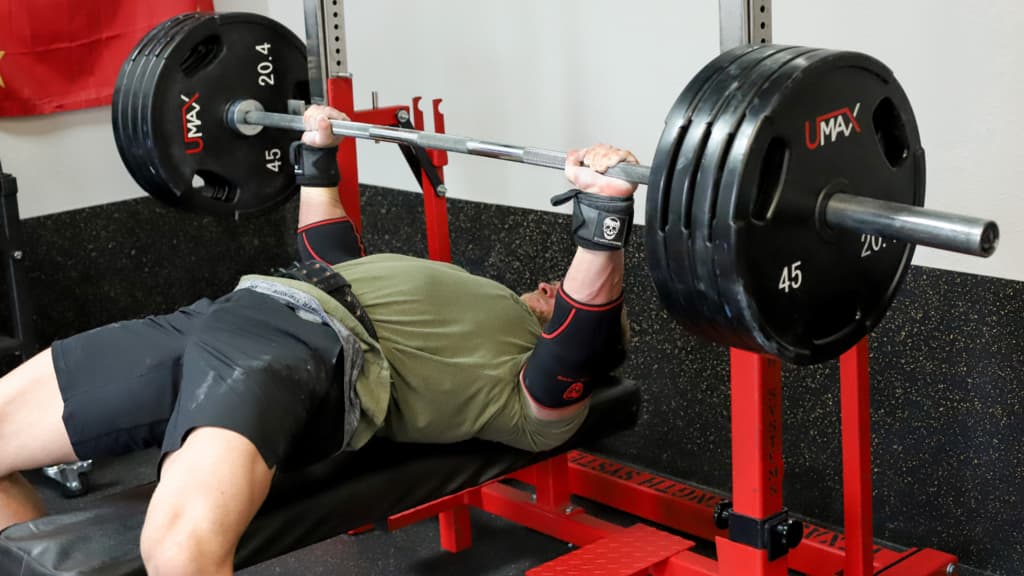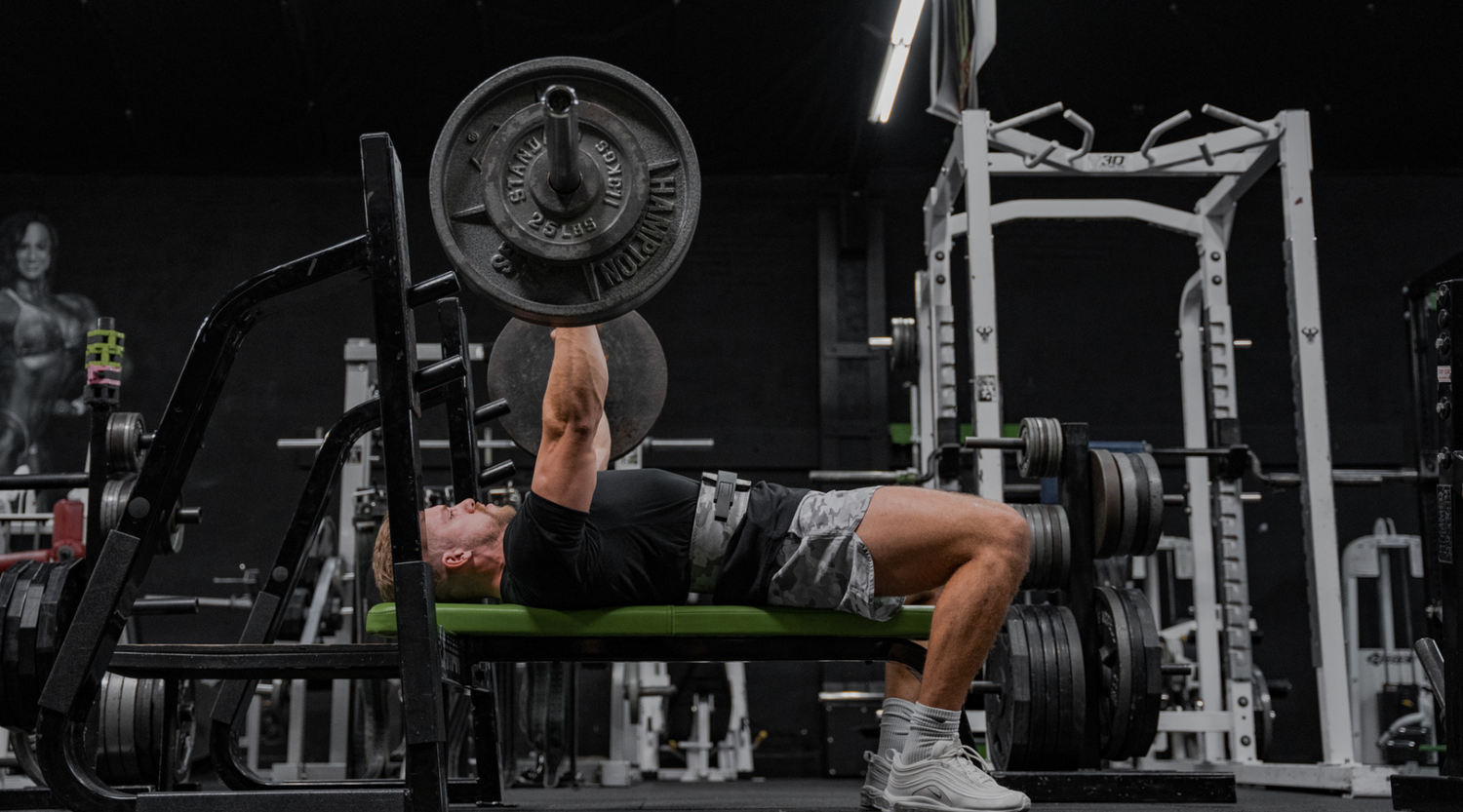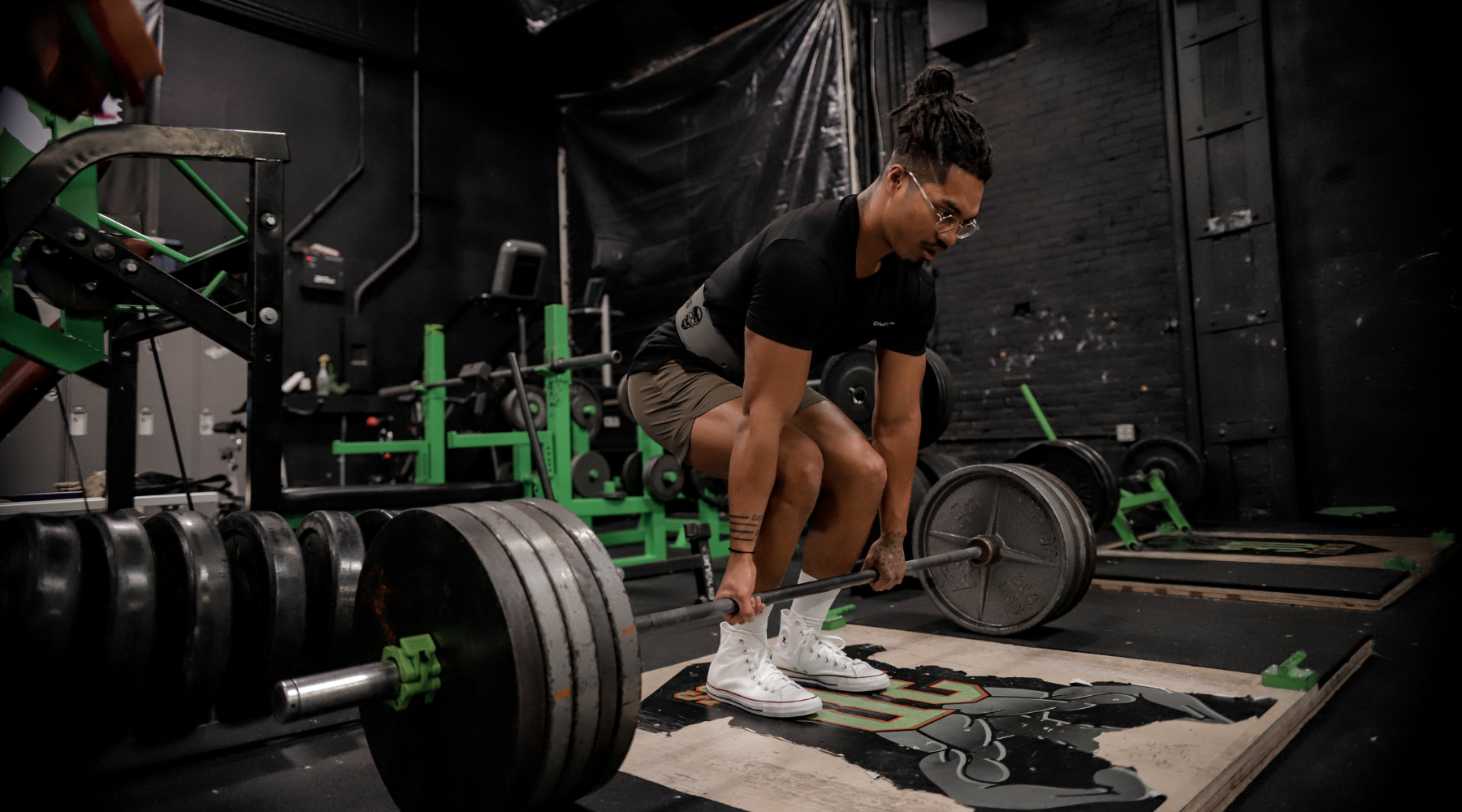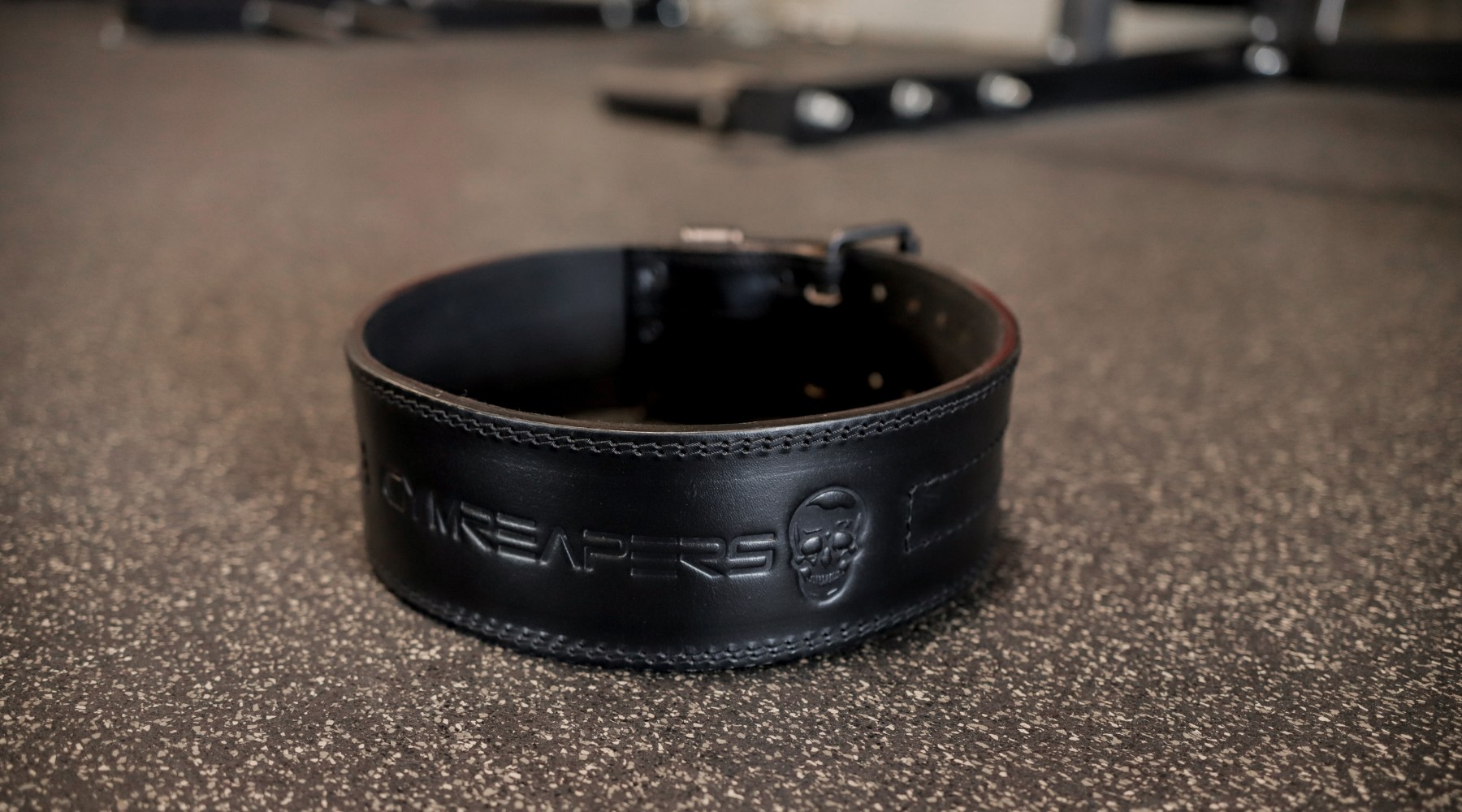It seems pretty common nowadays to see someone wearing a lifting belt for squats, deadlifts, or even overhead press, but you may find yourself asking:
Should I be wearing a belt when bench pressing, too? The simple answer is, yes.
Research indicates that wearing a lifting belt while benching can enhance your ability to activate muscles in your legs and core, which allow you to generate more force, become more stable, and create a stronger arch. On top of this, many lifters report feeling more confident under heavier load when wearing their belt.
As always, you have to remember that a lifting belt is not a magical cure-all that will lead you to a 4-plate bench press.
Below, I’m going to discuss the science behind your belt in more detail, as well as talk about how you should be wearing and using your belt to make sure you don’t run into problems commonly faced by lifters trying a belt on bench for the first time.
Key Takeaways
- Wearing a lifting belt can help you recruit more muscle fibers in your legs and core, which can enhance your stability and positioning and lead to a bigger bench.
- A lifting belt can help reduce low back pain and fatigue when benching, but should always be used as a tool, not a crutch. Make sure your belt isn’t masking underlying problems in your body.
- You do not need a special size belt for your bench press. Any 10 or 13mm, 4-inch leather powerlifting belt will do the trick provided you have it placed and tightened properly.
The Science Behind Wearing A Belt For Bench Press

Enhanced Muscle Activation in your Legs and Core
If you are bench pressing with any form of an arch (where your lower back doesn’t touch the base of the bench), the chances are very high that you use your legs and core muscles to remain tight and keep yourself in this arched position.
Multiple studies have indicated that wearing a belt increases the recruitment of muscle fibers in participants’ legs and core muscles when squatting and deadlifting.
While participants in these studies did not attempt the bench press, this data can be extrapolated to deduce that wearing a belt for bench press can also help you recruit more muscle fibers with the correct technique.
This lines up well with more anecdotal evidence, as many of the best bench pressers in the world report that the main core muscles aided when wearing a belt to bench press are the serratus anterior muscles (the muscles that wrap around the rib cage).
These are incredibly important for shoulder positioning, and wearing a belt enhances their recruitment, which can give the presser a more stable bench arch.
These more anecdotal experiences have been researched by Kaur and colleagues in 2014, in which their research indicated that the serratus anterior can be stabilized if the obliques are active.
All of this leads to a bench press in which the shoulders are able to maintain a better position (pulled down and back) and less likely to suffer from impingements.
Additionally, many bench pressers utilize a “ribs up” cue, in which they attempt to reach their ribcage to the ceiling as the bar descends to their chest.
This shortens the range of motion, but requires significant abdominal and leg force - something a belt can assist with, especially as you’re bracing into it when you bring the barbell toward your chest.
External Cues for the Lifter
In addition to the science behind a lifting belt aiding a lifter in recruiting certain muscle fibers that can result in a more stable press, wearing a lifting belt can also serve as an external reminder to create tension throughout your whole body.
Many lifters inherently get tight and rigid for squats and deadlift, but find themselves unable to recreate the same level of stable bracing when they bench press.
This is mostly because movements that are axial loading (where the spine is loaded vertically), creating tension is necessary to take pounds of force off of your spine (Hukins et al, 1990).
Your spine is loaded in a horizontal plane on the bench, and thus your body does not naturally get as tight to protect itself.
Thus, for many that have a difficult time getting tight to bench efficiently, adding in a belt serves as an external reminder to do so.
Many think of it as being akin to putting on your battle armour. When your armour is on, you flip the switch and know that it is time to get after it.
Accordingly, with this external reminder of putting on one’s armour, many lifters report experiencing improved confidence even if they do not experience a true physical performance benefit when wearing a belt.
Feeling more confident under heavier load can absolutely impact a lifter’s success in the lift, and anything that can enhance confidence should be considered a positive influence on a lifter.
A further external cue that lifters may often find a belt helps is to support their bench arch.
Some may have a difficult time extending their low and mid-back upward to create a substantial arch, and wearing a belt can potentially allow you to hold your arch better under a heavier load.
Reduce Pain and Fatigue in the Low Back
Many lifters with a genuinely tight and secure bench set-up report low back pain and fatigue when exerting maximal force during the bench press.
This is especially true for powerlifters that often squat or deadlift before they bench, which means their low backs are already experiencing fatigue.
Wearing a lifting belt might help mitigate potential flare-ups of back pain that can occur when bench pressing.
This is because the belt will help a lifter create more intra abdominal pressure when benching, which can reduce some shearing force on their spine and recruit more muscle fibers in their lower back.
Who Should Wear A Belt For Bench Press

Competitive Powerlifters
The largest demographic of people that should wear a belt for bench press are competitive powerlifters.
Competitive powerlifters bench press much more frequently than most other groups of people that lift weights (3-4 times a week).
Because of this, they will most often benefit from some of the advantages to wearing a belt when benching, namely helping their arch, being tight and confident under heavy loads, and reducing lower back fatigue.
I personally know many powerlifters in the heavier weight class who almost exclusively bench with a belt. Anecdotally, it seems like the larger and heavier athletes benefit the most from wearing a belt during their bench press
Even more specifically, I would argue that every person who takes part in equipped powerlifting should use a belt to keep their bench shirt in place.
When lifting with a bench shirt, equipped lifters typically have the shirt pulled down, and without a belt, the shirt will ride back up as the lifter gets set to bench.
This can reduce the effectiveness of a shirt, create a poor bar bath, and can result in serious injury to the lifter.
Lifters that Struggle with Confidence Under Heavy Loads
In addition to competitive powerlifters, I might recommend a belt for those lifted who struggle with confidence and consistency when trying to bench heavy loads.
In addition to the scientific evidence mentioned above that a belt can help athletes get tighter, which means they can recruit more muscle fibers and often become more consistent in their technique, I also believe there is a psychological benefit that these lifters can gain from wearing their belt.
Like I mentioned above, putting on your belt can give a lifter a psychological edge.
It adds a controllable step to their routine, can be an extrinsic reminder of the seriousness of the lift and the focus that it will demand, and can even make lifters feel safer when attempting loads that are challenging for them.
People with Lower Back Problems that Are Alleviated by Their Belt
Finally, I would also recommend wearing a belt for bench press to any lifter that finds the belt helps alleviate lower back problems.
Remember that a lifting belt is never a cure for back pain, and you should always take steps to address the underlying problems that you may be having.
However, in a pinch, your lifting belt can certainly be used as part of a well-rounded rehabilitation program to continue to lift heavy and prevent flare ups.
Just be sure to remember that lower back pain can be caused by a variety of factors such as form, intensity of training, or even lack of sleep and poor nutrition.
I always recommend finding the underlying cause of your problem so that you can continue to train heavily without risk of worsening your condition.
For more explanation as to why someone might want to wear a belt for bench press, and some of the benefits they can get from this, check out:
When Should You Start Wearing A Belt For Bench Press
If you are just beginning to use your lifting belt for bench press, I would recommend practicing all of your warm up sets with the belt.
In most other cases, like for the squat and deadlift, I recommend completing most of your warm ups beltless, as it gives you an opportunity to practice your bracing mechanics without the external feedback of your belt.
However, in my opinion, wearing a belt for bench press requires a completely different approach.
This is because the bench press movement may become significantly different depending on how you are able to set your arch and start position.
In most use cases, you will have to modify certain features of your bench in order to get comfortable with a different technique. These features may be things like foot position, grip, or the way you set your upper back into the bench.
As such, I recommend taking as many bench press reps as possible with your belt so that you can adapt to the movement and become comfortable with the technique.
Once you are comfortable with wearing your belt with bench pressing, I would then recommend taking most of your warm ups beltless, and then incorporate your belt once you get above 60% of your one-rep max, or are attempting a very challenging set with a lighter weight but plenty of reps.
How Should You Wear Your Belt For Bench Press
Position
As a general rule of thumb, the belt should be positioned at your waist, usually at the lowest point before running into your hip bones.
This may be a very different position from how you would wear your belt for squats or deadlifts; however, you should note that positioning can vary from person to person.
The ultimate goal when positioning your belt for bench press is to place it in a spot that allows you to brace your core effectively, but also does not impede your arch.
The most important key to remember here is that you need to remain patient. I recommend giving your belt on bench press an honest 1-2 months of consistent trials before deciding whether or not you will stick with it.
Tightness
Your belt should not be cinched too tightly so that you feel like you are wearing a corset.
Having your belt cinched too tightly can cause a variety of problems. It will take away your ability to breathe and brace properly, it might hyperextend your low back and lead to more pain than necessary, can cause shortness of breath or dizziness, and will just generally be uncomfortable.
If you can stick 1-2 fingers between your belt and your stomach when it is latched, it is probably tight enough. Just make sure that it feels tight when you take a full breath deep into your stomach, and is not so loose that it slides into different positions.
Are There Any Cons To Wearing A Belt For Bench Press
Masking Underlying Problems
As I mentioned earlier in this article, some people find themselves in the market for a lifting belt solely because their lower back is hurting.
I do not think this is a smart reason to be buying a lifting belt. It should only be used as a tool to augment your training and maybe provide brief relief from mild symptoms. A lifting belt will not solely keep you injury free.
That being said, I always recommend covering all of your bases to understand the root cause of your pain.
This may mean seeking out the help of a specialist, a coach, tweaking your form or warm up routine, or even changing your approach to variables outside of the gym (like sleep and nutrition).
Decreasing Your Arch
While I believe that, when used properly, a lifting belt can be used to augment and increase your arch, some people think that the opposite is true.
In my opinion, there are two issues that need to be considered when deciding whether a belt is helping or hindering your arch.
The first point to consider is that, while it may be true that you can arch slightly more when benching without a belt, the question is whether or not you can sustain that level of arch when under heavy load or through multiple repetitions.
I believe that, in most use cases, when a belt is placed properly, is of the correct thickness, and is at the right level of tightness, a belt will almost always help a lifter achieve a more consistent and stable arch that will not flatten under load or over time.
Secondly, as I just alluded to, most people that immediately forego benching with a belt need to consider whether or not their placement is correct.
If you only try one position and have not taken the time to experiment and collect usable data in your training with a belt, then I think it may be worth revisiting.
Restricting Your Breathing
This issue is very dependent on the individual lifter, and can only be confirmed or denied by personal experience.
Some lifters that I have spoken to have reported that they find it much harder to breathe while wearing a belt for their bench press sets.
I cannot find any studies that confirm or deny these reports, but in my personal experience, I have also noticed that it is more difficult to get an adequate amount of air when wearing a belt for high rep sets.
However, I do not usually find this to be the case when attempting any bench sets of less than 5 reps.
Can Be Impractical and a Hassle
Remember that your decision to wear a lifting belt for bench press has to be practical for you.
If you find bringing your belt to the gym to bench incredibly inconvenient and a hassle, then there is a very small likelihood that you will consistently implement it into your training.
If you don’t implement it consistently, you likely won’t derive very much benefit as your training will always be different.
I find this to be much less of a con for powerlifters, as our belt is part of our essentials in the gym bag. You’ll rarely find me anywhere without my lifting belt, no matter the impracticality or inconvenience.
Characteristics For A Bench Press Belt

As a general rule of thumb, I personally think that your regular 10 or 13mm thick, 4-inch wide lifting belt is more than enough to do the job as a bench-press belt.
This means that any characteristics for a bench press belt are the same as what I would recommend for any general lifting belt.
For most, I would recommend getting a leather belt from a trusted brand, with either a lever or single-prong fastening mechanism. These belts are durable, will keep you stable in any heavy compound movement, and are incredibly safe and reliable.
I know that some bench press specialists use a special 2 or 3-inch belt that you likely will have no use for in any of your other lifts, but I think this is overkill for the vast majority of lifters.
Your regular 4 inch belt will not decrease performance whatsoever, if it is placed and tightened properly.
On top of this, it can become quite costly to set a trend of purchasing very niche pieces of equipment like this, and it could even result in you having to bring more than one belt to the gym at a time, depending on your training.
Best Belt For Bench Press
Some examples of high-quality lifting belts that are going to be great for your bench press, and can also be incorporated into any other compound movement, are:
Frequently Asked Questions
Can You Bench Press More With A Belt?
Yes! If you have placed and tightened your belt properly, studies have shown that wearing a lifting belt for bench press can augment your arch and recruit more of your stabilizing muscles in your core and back. This in turn leads to lifters being able to apply more force and bench press more weight.













Leave a comment
All comments are moderated before being published.
This site is protected by hCaptcha and the hCaptcha Privacy Policy and Terms of Service apply.